

The commercial world has never been more competitive. Whatever your niche, consumers have never had more choice. It’s also never been easier for them to understand their options and switch allegiances.
Businesses must work harder than ever to engage customers and keep them on side. Onboarding email campaigns are a vital weapon in a company’s arsenal for doing just that.
If you’re not sure what an onboarding email is, much less how to craft one, you’re in the right place. Read on, and you’ll learn everything you need to know. We’re going to discuss onboarding emails and their value. We’ll then go on to highlight some examples from which to take inspiration.
What are Onboarding Emails?
Modern brands understand the importance of customer experience (CX). CX is the sum total of a customer’s perceptions of a business, built up from all their interactions with that firm.
Delivering excellent CX, then, is about excelling at every touchpoint through the customer journey. That’s where an onboarding email campaign comes in.
Onboarding emails get sent straight after a new customer buys a product or – more often – signs up to a service. They immediately show a customer that the brand in question appreciates their business.
They can also serve a range of further purposes:
- Welcoming the new customer to the fold
- Offering instruction as to how to use their product or service
- Encouraging further engagement and interaction
- Cross or upselling other offerings
- Answering any and all other questions a new customer may have
Ten Outstanding Onboarding Email Examples
The broad utility of onboarding emails explains why they’re something you can’t do without. Don’t worry, though, if you’re still a little sketchy on how to craft them. That’s where the following examples can help.
We’ve drawn together ten examples of the kinds of onboarding email you may wish to consider. Let’s look at each in turn, pinpoint its advantages, and discuss how you might create such a campaign for your brand.
Send automated onboarding emails with SendinblueFree plan includes access to all core email features, 300 emails/day, 40+ email templates, and customizable signup forms to grow your email list. |
1. A Warm Welcome
Some onboarding emails – certainly those that are the first of a series – are purely designed to welcome new customers.
The key to these messages is for them to be fun, engaging, and not too salesy. What you’re looking to do is to show a consumer your gratitude that they’ve chosen your business.
You can get to more practical matters – explaining your offering, selling more products, – later.
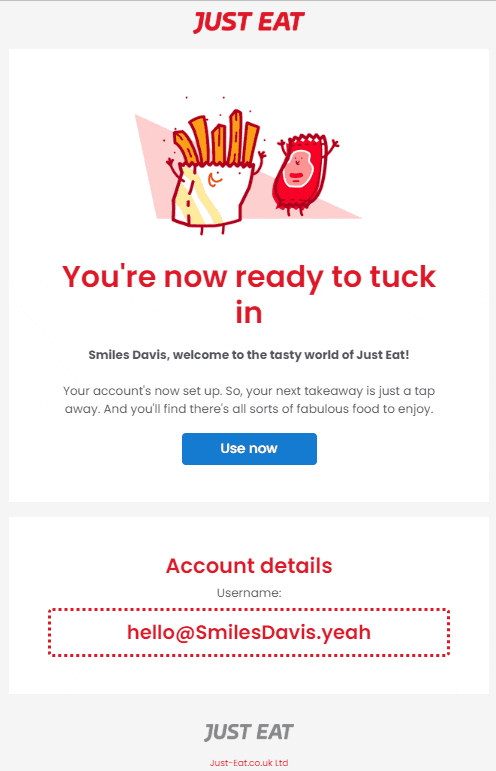

Take the above example from Just Eat. Their onboarding email features a fun animated gif, humorous tagline, and little else. They’re not offering much in the way of extra information or doing the hard sell of their service. They’re merely trying to welcome a new customer and make them smile.
The precise contents of such an onboarding email will differ from one firm to the next. You might choose to include contact details like a business phone number.
You may add an image or screenshot of your product. What’s vital, though, is to keep it light and engaging.
Want to know all the dos and don’ts of using GIFs in email? Read our Guide to Animated GIFs in Email
2. An Explainer
For many firms, a customer signing up for their service is only the start. To get a new customer engaged and boost the chances of retention, they need them to start using the product. The sooner they learn the benefits of the offering, the better. That’s why lots of brands treat an initial onboarding email is a kind of explainer.
As well as welcoming a customer, these messages also lay out the basics of the service to which they’ve signed up. It’s a handy way of reminding the consumer why they did buy their subscription. It will also nudge them toward using the service to reap the benefits the email reiterated to them.
3. Next Steps
Aptly, this example of an onboarding email takes things a step further from the explainer. Rather than showing the benefits of a product, this type of message guides recipients toward gaining them. Many brands send emails that lay out the steps a new customer can take to get the most out of their service.


As the above example shows, these messages don’t need to be dry or dull. You can keep things light and attractive via good design. What you must do, though, is make it clear what steps a customer needs to take. Make it as easy as possible to engage further with your product, and they’re more likely to do so.
4. Community Building
Sometimes you’re not looking for an email recipient to do anything. Your onboarding message doesn’t have to spur a customer on to take action. Instead, it can show them that by choosing your firm, they’ve joined a tight-knit group. You’re looking to foster a sense of belonging and community.
Many brands use a sense of community to aid customer loyalty. More than that, consumers who have an emotional connection to a brand can grow into advocates. They’ll fiercely defend their chosen community. They’ll also promote it over others – i.e., those attached to other brands. That’s the principal value of this type of onboarding email.
Here’s an example of a community building welcome email from Backcountry.


5. Keeping it Simple
Whatever the goal of your onboarding campaign, your emails don’t have to be complicated. Flashy design is all very well, but often recipients respond best to simplicity. Take a look at the below example from Flow.
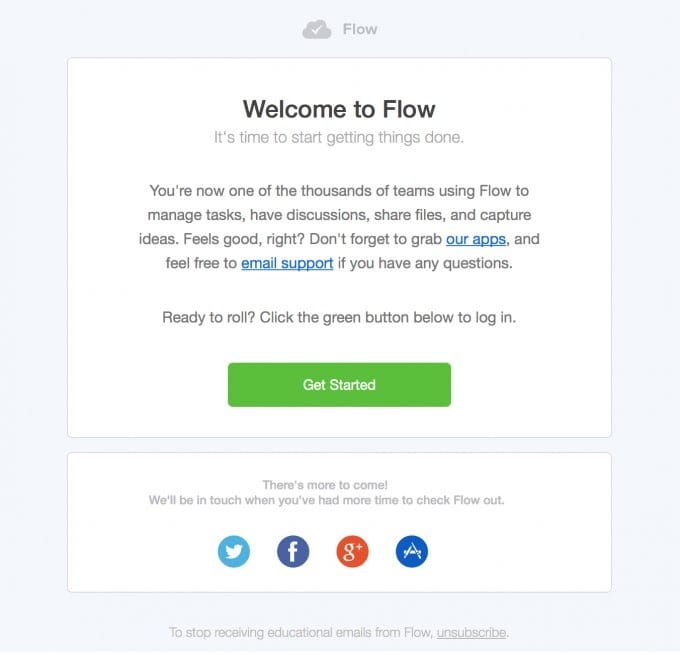

The message defines ‘keeping it simple’. There are no graphics or images and little text. In a short and punchy email, though, the company achieves a lot.
They promote their collection of apps and provide a link to email support. They also have a clear CTA to get a user started with their product. All that comes in a message that’s not so long as to allow a reader to get bored.
6. Cross & Upselling
You can use an onboarding email to try to boost your turnover, as well as for customer retention. These messages get sent to a specific audience. That’s an audience made up of people you already know are interested in your products. They may, therefore, also want to take advantage of some of your other offerings.
Say, for instance, that you someone has signed up for your teleconference software. That customer may also benefit from using a file-sharing solution that you also happen to offer.
You can use your onboarding email to point that out to them. If you’re successful in this cross-selling, you’ll get two principal benefits. You make an additional sale, and you boost the level of engagement of the customer with your brand.
Here’s an example from Howler Brothers:
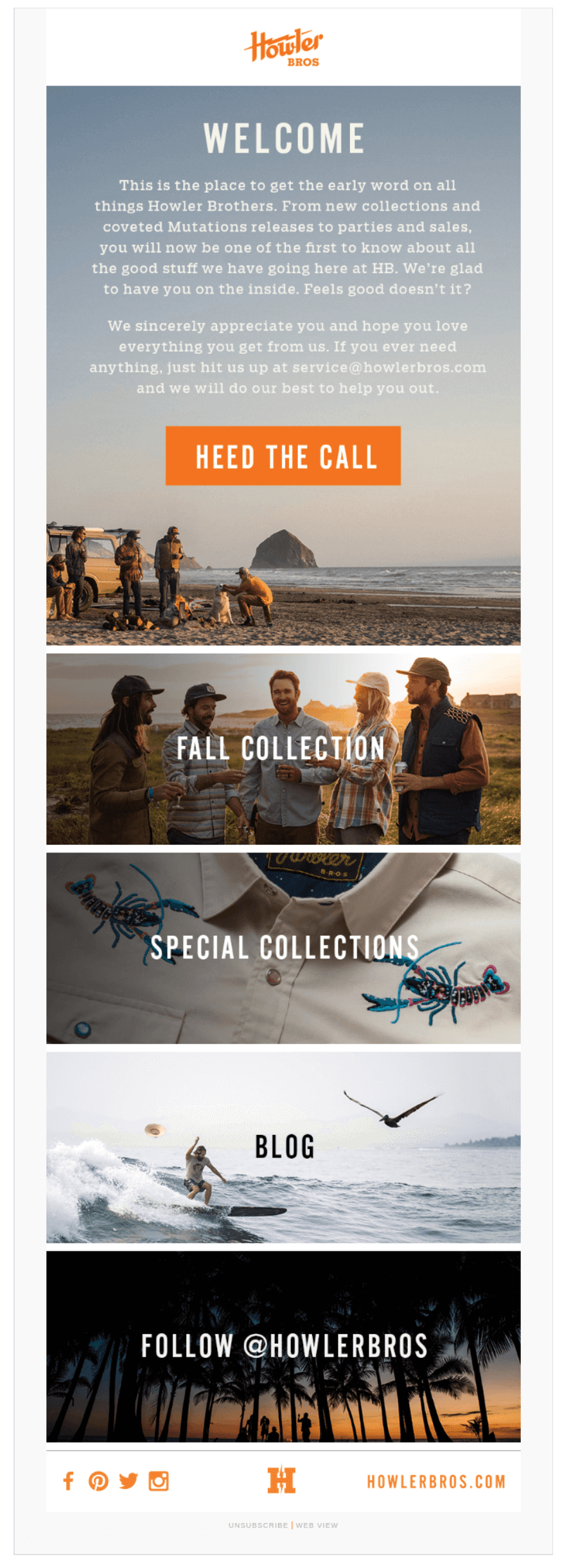

7. Gamification
Engaging new customers isn’t necessarily about getting more money from them. It also doesn’t have to be serious. You can connect more deeply with people by having a bit of fun with them. That’s where gamification comes in.
People love a game or a quiz. They like them even more when they can distract them from a tedious task – like clearing their inbox. Pop a light-hearted quiz in your onboarding email, and you’re sure to grab the recipients’ attention.
Here’s an awesome onboarding email from The Glenlivet which introduces the brand and uses a quiz to gains insights on subscriber preferences.


8. Rewards & Encouragement
Generating customer engagement is often about understanding human psychology. We all like to get a sense of achievement and to get rewarded for our endeavors. That’s why onboarding emails with simple words of congratulation or encouragement are often a winner.
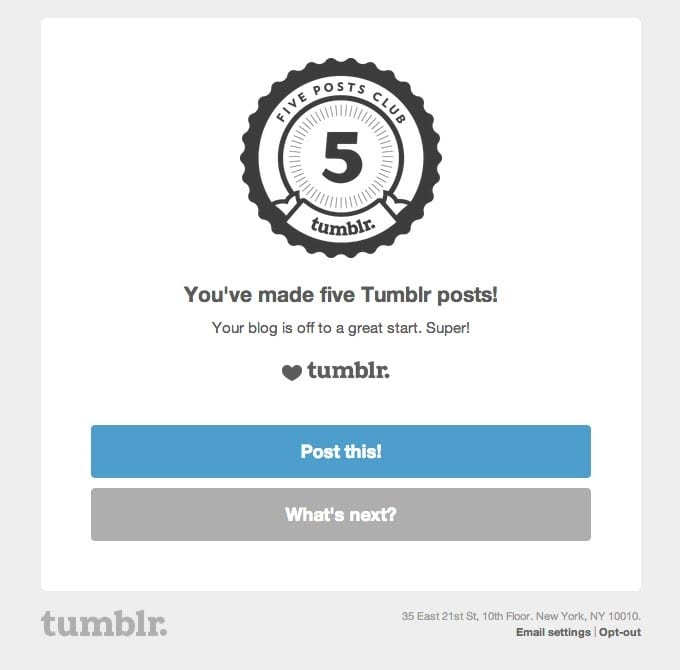

Microblogging company Tumblr are great at these types of campaign. They send users messages like the one above to mark each landmark reached in using their service.
Such messages give recipients a little boost. They also make them more determined to reach the next ‘level’. That, in turn, means they’re more likely to pay greater attention to the product in question.
9. Leveraging Video
Visuals can elevate a message to an entirely new level. It’s why newsletters and other emails so often include images and graphics. Embedded videos in emails can be more useful still. It takes reams of text to convey the same amount of information as you can via a short video clip. What’s more, people retain details they see in a video for far longer.
When it comes to an onboarding email, there are loads of video options to consider. For example, you might use a clip to swiftly explain your product’s features. This is an excellent idea as it shows your customers more clearly how to use all the aspects of your service. People in general, too, are more likely to watch a short clip than read a long list of instructions.
Further reading: How to Embed Video in Email
10. Personality & Personalization
Today’s consumers expect a personal touch from the brands with which they interact. The kind of individualized service that small, local businesses excel at, must now translate to the online world. In terms of onboarding messages, that means leveraging personalization where you can.
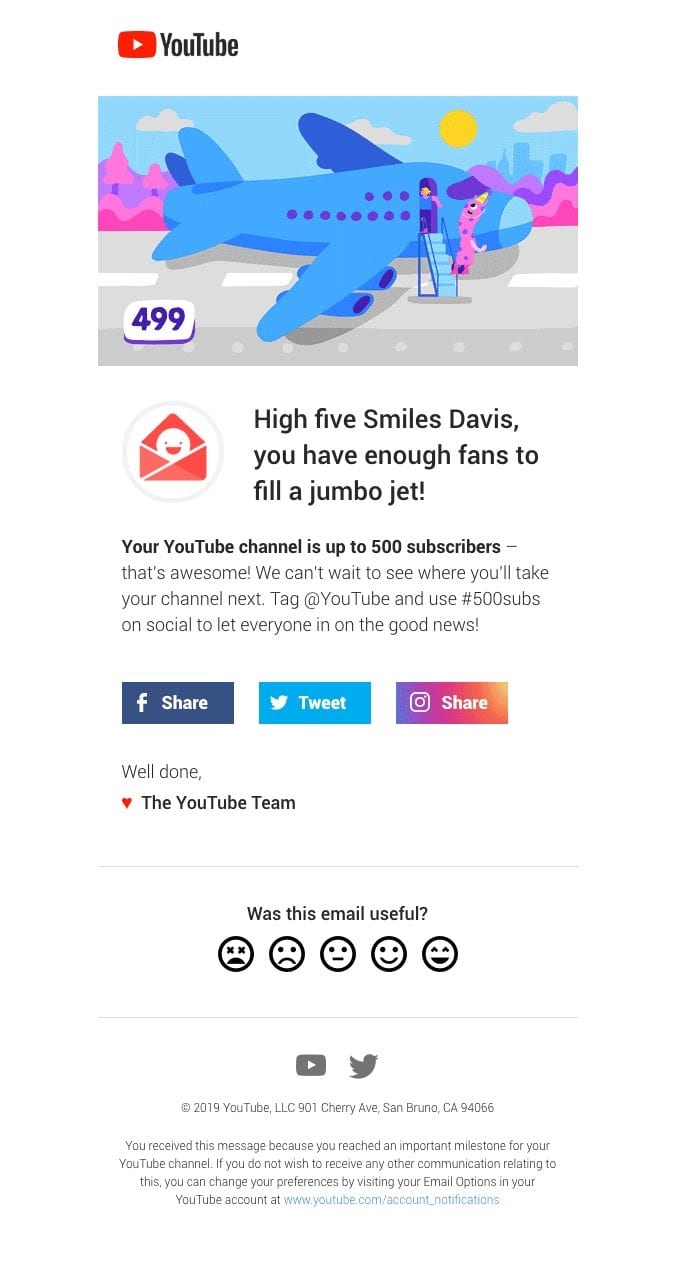

The above example shows two significant aspects of email personalization. First, it addresses the email recipient by name. Then, the whole tone is friendly and conversational. It helps to humanize the brand – in this case, YouTube – and makes the recipient feel closer to the company.
The Onboarding Email – Essential for Customer Acquisition & Retention
There’s no shortage of options regarding the type of onboarding emails you may create and send.
Whichever way you choose to go, a successful onboarding campaign can be a real shot in the arm for your brand. That’s due to the benefits the emails offer for both customer retention and acquisition.
The principal benefit of onboarding is that it engages new customers. You create a closer connection and thus have a better chance of retaining their business.
Beyond that, though, great onboarding can also earn you new business. Engaged customers are more likely to buy your other products. They’ll also advocate for your brand and recommend you to friends and colleagues.
Getting onboarding right is a win-win.
 Deutsch
Deutsch




















